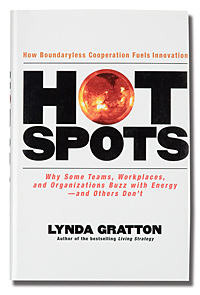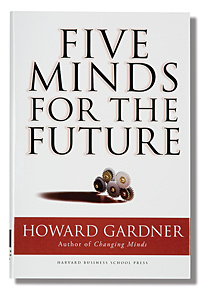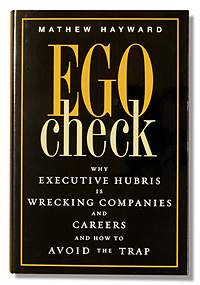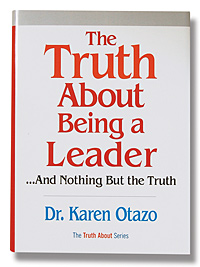Best Business Books: Human Capital
An Appetite for Effectiveness
(originally published by Booz & Company)
Howard Gardner
Five Minds for the Future
(Harvard Business School Press, 2007)
Lynda Gratton
Hot Spots: Why Some Teams, Workplaces, and Organizations Buzz with Energy — and Others Don’t
(Berrett-Koehler, 2007)
Mathew Hayward
Ego Check: Why Executive Hubris Is Wrecking Companies and Careers and How to Avoid the Trap
(Kaplan Business, 2007)
Bruce L. Katcher with Adam Snyder
30 Reasons Employees Hate Their Managers: What Your People May Be Thinking and What You Can Do about It
(AMACOM/American Management Association, 2007)
Karen Otazo
The Truth about Being a Leader… and Nothing But the Truth
(Financial Times Press, 2006)
According to Hindu mythology, from time to time, God has appeared on earth in different incarnations to redeem humankind. One such incarnation was Lord Krishna, who was born into the Yadava clan.
The main character in the central narrative of the Mahabharata epic, Arjuna, was a superb archer and formidable fighter in a war between two families. Arjuna was always victorious in battle; he was a bit like the ever-successful CEO of modern days. However, he was vain and hubristic, also like many a modern CEO. Lord Krishna was Arjuna’s mentor.
One day, the Yadava clan played a trick on three sages who, in retaliation, cursed the clan, vowing that it would one day destroy itself. As the curse took effect, the Yadavas began to kill one another. At an advanced stage of the crisis, Lord Krishna implored the artful archer and “turnaround CEO” Arjuna to save the Yadava women and thus the clan. Arjuna did so with acts of great valor. As he rode away victorious, the Yadava women in his chariots, bandits attacked the entourage. Again, Arjuna fought valiantly. This time, however, several women were slain. Arjuna’s arrows did not protect them.
Mysteriously, Arjuna had lost his powers. Of this story, the 16th-century Indian poet Tulsidas wrote lyrically:
The same Arjuna with his arrows
failed miserably this time,
Truly, luck and timing influence
success in ways sublime,
This is an important lesson
to remember at all times.
Through the ages, in war and business, experience and skills have been greatly valued. However, luck and timing also seem to play some role, though the precise nature of this role has been unclear. The puzzle of what defines, and what diminishes, leaders is as intriguing to 21st-century publishers as it was to a 16th-century poet. Each year, scores of books are published that attempt to reveal the “truths” or “secrets” of success in management, especially as they relate to managing people. This year, I scanned many with titles that held out the promise of delivering new insights, and read five of them.
My experience with two of the five (Hot Spots: Why Some Teams, Workplaces, and Organizations Buzz with Energy — and Others Don’t, by London Business School Professor Lynda Gratton, and Five Minds for the Future, by Harvard psychologist Howard Gardner) felt like dining in a fine French restaurant, enjoying a well-balanced meal topped off with a fine Merlot rich in antioxidants. “Fine dining” in the context of reading books about managing people (or to use the phrase du jour, human capital) translates to a full plate of academic scholarship exploring theories of the mind, individual and organizational behavior, and how leaders create conditions and perform in a way that leads to successful outcomes.
A third book, Ego Check: Why Executive Hubris Is Wrecking Companies and Careers and How to Avoid the Trap, by Mathew Hayward, is also a balanced meal, but without the wine. The emphasis is greater on anecdotal lessons and practical wisdom than on academic scholarship. Hayward, a former consultant at Accenture and then an investment banker, earned a Ph.D. in organizational behavior and strategy at Columbia University and is now a professor at the University of Colorado’s Leeds School of Business. He seasons his book with management experience, and has a knack for storytelling.
For those hungry for the energizing but fleeting stimulation of carbohydrates, Karen Otazo’s The Truth about Being a Leader…and Nothing But the Truth and 30 Reasons Employees Hate Their Managers: What Your People May Be Thinking and What You Can Do about It, by Bruce L. Katcher with Adam Snyder, offer formulaic numbered lists of truths and reasons. It’s easy to be critical of quick-fix management fare, but such “fast-food” books can serve a purpose: They present functional tips, which are valued by those in a hurry.
 Creating Hot Spots
Creating Hot Spots
I have observed that over the last half century, management styles have changed significantly. The essence of leadership has shifted from the directive and logical toward the inclusive and humane. Managers value freedom over control. They view participation to be as important a factor in effective leadership as direction. They expect productivity as well as creativity.
Lynda Gratton’s Hot Spots addresses the demands of today’s business world. Named twice as one of the world’s top management thinkers by The (London) Times, Gratton uses evocative metaphors to succinctly communicate her ideas. For example, when she describes the feeling of a Hot Spot (“time seems to rush by as you and those around you are ‘in the flow’”), she also asks the reader to imagine standing on the peak of a mountain, looking out over the landscape through thermal-imaging goggles. You don’t need to have had this experience to appreciate the rush of eyeing such a spectacular scene through these lenses.
Hot Spots are places within an organization where relationships and cooperation flourish, creating great energy, innovation, productivity, and excitement. Gratton’s key message is that “relationships between employees build organizational value, and through these relationships individuals grow.” Every operating manager has learned the hard way that the ability to cajole, persuade, threaten, and motivate groups like this is the key to getting things done.
Gratton describes how Hot Spots are the product of a multiplier effect among four elements: “cooperative mindset,” “boundary spanning,” “igniting purpose,” and “productive capacity.”
Leaders who cleverly draw out their group’s intellectual, social, and emotional energy generate the first element, the cooperative mind-set. Five years ago, Ratan Tata, chairman of Tata Group, where I work, asked his leadership team an apparently simple question: “If foreign companies can succeed in India, how can we acquire companies and succeed in foreign countries?” It unleashed an energy that has enabled Tata Group to acquire the Ritz-Carlton in Boston and the Campton Place Hotel in San Francisco, to manage the Pierre in New York City, and to acquire the British steelmaker Corus and the Korean truck maker Daewoo. Today, Tata Group gets more sales revenue from outside India than from inside, a dramatically different situation from just five years ago.
Gratton defines the second element, boundary spanning, as the capacity of people to exchange and combine knowledge. For instance, the book describes Carlos, a manager for BP in Venezuela who works across time zones, languages, and cultural differences to collaborate with Polly, the head of the Polish business team. Polly needs to turn around her business and Carlos supports her by sharing his own experiences. They meet only a couple of times, but Gratton explains how the pair end up creating a Hot Spot.
In writing about spanning boundaries, the author doesn’t gloss over the challenges of cross-cultural communications. For example, she writes, “Some countries, particularly Asian countries, are more collectivistic; by contrast, the people in most Western countries are more autonomous.” Having worked for global multinationals for three decades, I appreciate such sensitivity. For Westerners, getting a point of view across clearly is more important than protecting the recipient’s feelings. The opposite is true in Asia.
A cooperative mind-set and boundary spanning lay the foundation for Hot Spots, but are not sufficient to trigger them. The third element needed, Gratton writes, is igniting purpose. Managers trained in the command-and-control style of management are generally taught to tell their people clearly what is expected, and then drive them to deliver. However, to ignite purpose, managers need to do the reverse. For instance, she says that ambiguous questions and tasks are more interesting and motivational for people than step-by-step instructions.
Ratan Tata asks his managers to think about questions such as, What does it take to build a safe passenger car for only US$2,000? or Isn’t it possible to have a functional, clean hotel room for the Indian business traveler for $20 per night? At Tata, I have witnessed how our managers explore these questions with vigor, and find the answers.
The fourth element is productive capacity. “The latent energy of cooperation has been ignited through purpose, and the boundary spanning has created the potential for innovation. But will the Hot Spot be productive?” asks Gratton. She then outlines five key productive practices, which follow a specific sequence and assume different levels of importance as the Hot Spot develops — appreciating talents, making commitments, resolving conflicts, synchronizing time, and establishing a rhythm. It seems a bit like the efforts of a sports captain or symphony conductor to consistently elicit the best performance from his or her team.
 Mind over Matter
Mind over Matter
Five Minds for the Future, my choice for the best book in this category, comes from a noted and sometimes controversial psychology–neuroscience researcher. The author, Howard Gardner, the John and Elisabeth Hobbs Professor of Cognition and Education at Harvard’s Graduate School of Education, has written almost a dozen scholarly books before this one. (See “Howard Gardner Does Good Work,” by Lawrence M. Fisher, s+b, Summer 2007.)
In Frames of Mind: The Theory of Multiple Intelligences, published in 1993, Gardner posited his theory of seven autonomous intelligences. Five of these are cognitive, such as logical, bodily-kinesthetic, and musical. The other two are forms of interpersonal intelligence, which Gardner says are “not well understood, elusive to study, but immensely important.”
The seven intelligences are abstract threads from the looms of Gardner’s mind, and are of limited use to the real-world manager. But in his latest book, Gardner weaves those threads into a whole fabric. The five minds for the future consist of three cognitive minds (“disciplinary,” “synthesizing,” and “creating”) and two minds that concern our relations with other human beings (“respectful” and “ethical”). Insightful and sometimes dense, Five Minds for the Future nonetheless tempts the reader to return to, and reflect on, many passages throughout the book. This is a hallmark of great scholarly writing. One example: “In studies of teams involved in cardiac surgery, [researchers] have documented that successful teamwork depends more on the management skills than the technical expertise of their leaders.” Another example: “The ultimate ethical stance encompasses both the workplace as well as the surrounding community…. What do I owe others, and especially those who — through the circumstances of birth or bad luck — are less fortunate than I am?”
Discipline is defined as a distinctive way of thinking about the world, informed by facts and figures we can memorize. Facts are useful, argues Gardner, but experimentation with such knowledge must follow. As Plato remarked, “Through education we need to help students find pleasure in what they have to learn.”
Like many other management scholars, Gardner points out the information age’s growing complexity and the need for a synthesizing mind to knit together into a coherent whole all the information that is available from different sources. When I began my career 40 years ago, it seemed possible to master most of the facts about my industry. When I was a young marketing manager, my boss goaded me to know more than anybody else in the company about my brand. Only then would I be ready for a promotion. Today’s marketing manager needs to understand the big picture, well beyond the knowledge of his or her brand.
Synthesis is hard because human beings tend to learn only what is needed in a specific context. We have evolved to survive in niches. That is why when successful managers move from one industry to another, they find it difficult to transfer their knowledge. Knowledge transfer requires creativity. Young people demonstrate Gardner’s creating mind better than older people do. We see this in science, where younger workers are more likely to achieve breakthroughs than are older workers, who typically do synthesis. That is because older people lack inexperience. Freud once observed that when he was young, ideas came to him; as he aged, he had to “go halfway to meet them.”
Of the two interpersonal minds, the respectful mind underscores the essential importance of affinity among human beings. For Gardner, being respectful means accepting our differences, learning to live with them, and valuing the traditions and habits of people who are different from us.
This approach is visible in multicultural societies such as the United States. India is an even more dramatic example: It is simultaneously heterogeneous and bound together as one, despite some superficial evidence to the contrary. There is a Sanskrit word, Swikriti, that means acceptance — the idea that people are entitled to lead their lives without any attempt to judge or compare the quality or standing of one group with reference to another. The inclusive attitude inspired by Swikriti made it easier for India to accept the traditions of Christians, Jews, Parsis, Muslims, and other “migrants” when they settled in India.
The ethical mind answers questions such as, What does it mean to be a citizen of my community? My own experience has been that it is easier for managers to carry out good work in organizations and institutions that basically strive to be good. For example, Tata is ultimately owned by charitable trusts. The group has an institution (not physical, but virtual) called the Tata Relief Committee (TRC). This is a nonfunctioning committee in normal times. When any national calamity strikes (such as the tsunami in 2005), the TRC assembles itself autonomously. It collects money from Tata employees and companies and offers to do volunteer work in cooperation with the authorities, for example, rebuilding homes. A company that strives to be good enables its managers to be good.
Gardner’s ideas about the ethical mind and the respectful mind seem to converge neatly with Gratton’s more practical discussion of boundary spanning. Gratton describes the boundary spanners as “chameleons who tend to be especially sensitive and skilled in bridging interests, professions, and organizations” and “have the capacity to acquire and value differences in others with regard to culture or mindset.”
It was these two types of intelligence that I believe led to the success of South Africa after the fall of apartheid. Under the leadership of President Nelson Mandela and of Archbishop Desmond Tutu and his Truth and Reconciliation Commission, we saw how an approach born of respect and concern for what is ethical led to a nationwide spirit of atonement that was extraordinary in its power to heal. In Gardner’s and Gratton’s terms, the two men demonstrated extraordinary interpersonal intelligence along with superior skill at boundary spanning. And it is because of their leadership that South Africa didn’t disintegrate.
 Crisis of Overconfidence
Crisis of Overconfidence
Mathew Hayward, the author of Ego Check, brings to his book the eclectic perspective of a merchant banker turned academic. Relying less on primary research than Gratton and Gardner, he astutely assembles other people’s research, anecdotes, and narratives. The book is filled with stories of familiar contemporary business leaders — Michael Dell, Hank Greenberg, Steve Jobs, Jean-Marie Messier, and many more. Both personal stories and news stories are retold with insight and wisdom. Hayward rewards you with the satisfaction you get when someone has beautifully articulated what you instinctively know, but fear you may forget at crucial times.
The key idea in his book is about overconfidence. Hayward does not deprecate overconfidence, which he says is essential for corporate success. On each of the three or four occasions when I have been involved in turning around a company, I must confess to exhibiting great confidence even though I did not know exactly how success would be achieved. But there is a good and a bad overconfidence.
Ego Check examines the bad kind of overconfidence and its four sources, all of which are easily recognizable. The first is “excessive or exaggerated pride.” This might come from a person’s concern with impressing other people. Or it can arise from the false sense of satisfaction leaders get from using self-serving data to inflate their accomplishments. Think about corporate leaders who try to show a positive turn in business performance at about the time they took charge.
The second source of the bad kind of overconfidence is “isolation.” In a chapter called “Getting Out of Our Own Way,” Hayward focuses on former Hewlett-Packard CEO Carly Fiorina. The pride she exhibited before her fall leads him to the conclusion that “few people were willing to tell her that she was wrong…. She insulated herself behind assistants within the executive suite and blamed deteriorating performance on subordinates. And she used guilt to tell people how much they had let her, the board, and the firm down.”
The third source for bad overconfidence: Executives get valuable feedback from people, but because it is contrary to their own views, they ignore or discount it. This Hayward describes as “selective judgment,” or “our propensity to make decisions about situations that are based on feedback that pleases us or fits our preconceptions of our situations.” Here he makes an example of Merck leaders who did not listen to the feedback on the harmful side effects and questionable safety of Vioxx. (The author reminds us that on September 30, 2004, the day then CEO Ray Gilmartin took the $2.5 billion-in-revenue drug used by 20 million Americans off the market, Merck lost $25 million in market capitalization.)
During the early 1990s, I witnessed a similar demonstration of bad overconfidence when working at Unilever: the fiasco in the U.K. over Persil laundry detergent. Persil contained a proprietary ingredient called the “accelerator” that helped it remove dirt significantly better than other products. It was launched with great fanfare, which died down when it became apparent that the accelerator not only cleaned garments, but shredded them. Photos of underwear with holes were displayed on the front pages of British newspapers to dramatize our failure to fully research the effects of this special cleaning ingredient.
The fourth source of bad overconfidence is leaders “underestimating the consequences” of their decisions. Quoting Stephen Covey from The Seven Habits of Highly Effective People, “While we are free to choose our actions, we are not free to choose the consequences,” Hayward similarly argues that failing to think about tomorrow fuels hubris in decision making today. Leadership failures during recent world news events, such as the Iraq war and Hurricane Katrina, illustrate his point without too many words.
 High-Carb Wisdom
High-Carb Wisdom
Karen Otazo, the author of The Truth about Being a Leader, is an executive coach with impressive international experience. She has worked with senior executives in multinationals around the world and claims fluency in Spanish, English, French, and Indonesian. But her book of 52 truths, arranged in 10 sections, each no more than four pages, seems to have a single and culturally universal message: Leaders are sized up by those they lead on the basis of how they speak, think, and behave.
Her lessons are framed as short and practical tips (no stories or anecdotes) telling leaders to say the right things and to do what they say. For example, truth number 4: “The gaps in your work habits show up when you move up.” Otazo’s advice to rising executives is to keep up with scheduling, to delegate using quality standards and due dates, and to make decisions clear. The author’s use of phrases such as “conjuring,” “tricks,” and “sleights of hand” seems out of place in a book about leadership. Nonetheless, her tips are useful and easy to remember.
Bruce L. Katcher, author of 30 Reasons Employees Hate Their Managers, is a management consultant whose firm conducts employee opinion polls and customer satisfaction surveys for Fortune 500 clients such as Alcoa, Johnson & Johnson, and Revlon. The book is based on survey research and interviews with 50,000 employees in 65 organizations, mostly in the U.S. Every chapter starts with a statistic from this research, for example, “46 percent of all employees believe that management treats them with disrespect” or “50 percent of employees believe that the time they spend at meetings is not time well spent.” Not exactly big news, but seeing statements like this in print can be striking. When employees don’t feel free to do their job, Katcher suggests, it may be because senior executives are too controlling. His solution: Rate and reward senior executives on how well they delegate.
Two kinds of people will find value in these two books. Otazo and Katcher are good guides for young executives beginning their careers. Many years ago, I benefited from similar books because they contained practical wisdom, not philosophical dissertations. More experienced executives short of time (and who isn’t?) can also benefit from commonsense reminders of how to handle everyday sticky management situations.
A Snack or a Meal
I won’t argue for the pleasures of fish and chips over filet of sole with bearnaise sauce. When we want to eat, a fast-food chain or an elegant restaurant offer different sorts of satisfaction. It is the same with books about human capital. There is an appropriate market and use for both “fine dining” and “fast food” guides, and it would be wrong to dismiss one in favor of the other.
For me, books with messages that linger and cause reflection have a special value. Books that make the scientific study of human behaviors accessible to the lay reader have also been helpful to me over the years. But whatever your taste or appetite for books on management leadership, a spoonful or a full plate reminds us of the capriciousness of human beings and the complexities involved in managing them.![]()
R. Gopalakrishnan (rgopal@tata.com) is the executive director of Tata Sons, based in Mumbai, India. He is the author of The Case of the Bonsai Manager: Lessons from Nature on Growing (Penguin Books India, 2007). He has held posts in India, the U.K., and Saudi Arabia with Unilever, Brooke Bond Lipton India, and most recently Tata Group.

